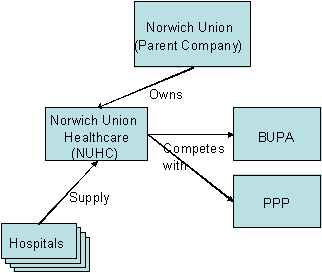
Case
|
Healthcare |
Organization Behaviour |
| During the late 1980s, a large insurance company, Norwich Union, decided to enter what was a new market for them, Healthcare. They did not know whether they would succeed in taking significant market share off the existing players such as BUPA and PPP so they started a new company simply called Norwich Union Healthcare (NUHC). This new company had an independent board but relied on the parent company for investment. |  |
To reduce the capital at stake in the new start-up, an old mainframe IT system was bought from the States, and the initial business processes were set up to use the functionality provided by this old system. In effect they chose to have a fully functioning company at minimum cost in order to test the market. The IT department had to cope with modifying an old system written twenty years previously and with little on-going support from the vendor.
With any insurance operation, but especially with Healthcare, the initial phase consists of selling policies: this establishes market share but the implications and costs of market share are deferred in time. The subsequent operation involves paying out on some of the policies, but this load of claims and administration costs only builds up slowly. Decisions about how to handle this subsequent phase can also be deferred to some degree.
Who took this decision – NUHC? When, why?
NUHC managed to take 10% market share quite quickly, so it looked as though it had a secure future. Once its customers were paying premiums, attention moved slowly to the cost base of the company and what it would have to pay out in claims. The established way to minimise the cost of meeting a given set of health insurance claims is to contract with low cost providers for the supply of operations for instance at a fixed price.
Having reduced the cost of the operations, patients who already have a diagnosis from their GP need to be channelled into these schemes, where appropriate. This appropriateness is a ticklish issue because the care provided must meet the actual need of the patient. This requires close co-operation between GP, NUHC and the healthcare provider. For instance if the hospitals concerned can shorted the length of time they treat patients in the hospital, the immediate costs go down drastically, but clearly this move should not incur future claims.
Since the existing mainframe IT system did not support managed care, the IT department started looking at the best way to support it. They used "consultants" from the IT department of the parent company to advise them on a suitable architecture for the solution. The advice they received was that because managed care implied communication between the systems of the partners in care provision, a three-layer architecture of clients, back office systems and middleware to handle the transaction system was appropriate.
The basis for this decision was the perceived need for progressive integration of the IT systems of their business partners – the hospitals providing care, dental practices etc. At stake here was a view that saw NUHC providing a service that genuinely integrated the administration of the care system. The alternative was merely to make sure that the advice given to patients over the phone was appropriate to the extent that it would not produce claims on insurance policies that would be refused under the terms of those policies.
Using the three-layer architecture, a view of NUHC as part of a network of business partners could be operationalised. Close links could be built with key partners so that key operational information could be shared. For instance, patients who rang up NUHC with a claim could be steered towards a treatment centre that had vacant beds.
NUHC made a decision that was based on a value-system in which partnership was viewed positively.
(This was an understandable error, given the apparently devious behaviour of the "consultants", but was ultimately fatal to the project.)
The business case that CTP helped build had a price tag for building the system of about £6M. NUHC put forward an investment case including this figure to the parent company.
The parent company now approached their own IT department for advice about the cost of building the system. Faced with this request they received advice that the system could be built for about £2M using the existing mainframe approach. The investment case was thrown out and had to be revised to include this lower cost approach.
We may presume that the (vertical) question posed by the parent company to its IT department was different from the (horizontal) question posed by the NUHC IT department (on a "consultancy" basis). The fact that the same IT department gave incompatible advice to two different questions on two different occasions doesn’t necessarily indicate inconsistency within the IT department – the inconsistency may be located in the questions, not in the answers.
In effect the view of building a network of business partners and collaborating to reduce the cost of service provision was unproved to the executives at Head Office. They still wanted to see the company develop at minimum up-front cost, and did not see themselves investing in partnerships and collaboration. The business the Head Office knew for themselves was much more centralised than the plans being put forward by NUHC.
It appears that this decision was based on a value-system in which partnership was viewed negatively. We could speculate that a (then) huge and dominant insurance company would not understand the logic of partnership, whereas the small and entrepreneurial NUHC with a reputation to make and fierce competition for market share in a new market could see it clearly.
The IT department at NUHC then had to change direction again and go back to building mainframe systems. Their investment in understanding architectural approaches and in training went to waste.
How are we to make sense of the diverse value systems hinted at in this case?
 |
 |
| [top] |
Copyright © 2002 Veryard Projects Ltd & Antelope Projects Ltd http://www.veryard.com/orgmgt/casehealthcare.htm |